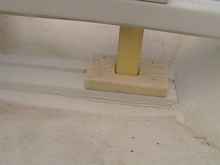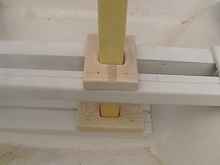| Send
items to [email protected]
for inclusion here next month.
The Treasure Chest is a place to put those cool sailing,
cruising, motoring, boatbuilding or boating tips you have. Send
us your ideas... We just need a photo and a short description.
This time we have...
Bulkheads, rope and pavers
Bend thin metal to get shape of bulkheads. Old pavers make great
weights (I found these ideas somewhere). If you are burning the
ends of a lot of rope, light a candle and use that flame. It saves
time and money.
Mike John
Fairing
I apply filler with a notched trowel and leave it harden. Sand
the ridges with the long board then fill in the remaining grooves.
Less stuff to sand that way...
Paul Esterle Freelance Boating Writer "Capt'n Pauley's Place"
The Virtual Boatyard www.thevirtualboatyard.com
Rope Stirrup
I thought some of your readers might be interested in this simple
device that I use on my 8' long John Spencer-designed Firebug
dinghy.

The boat is very easy to re-board after a capsize using this
rope stirrup. It is attached to two s/s saddles, one either side
of the rudder stock. When not in use it is tucked up neatly under
the piece of black bungee cord. When you put your foot on the
stirrup it is prevented from going under the boat by being able
to press against the rudder blade. Remounting the boat over the
stern makes it much easier to keep the boat head- to-wind throughout
the manoeuvre. I can be sailing again very quickly after arriving
in the water, and it's not an exercise that requires great upper-body
strength, which somehow seems to have deserted me over the years!
Hugh Blank
Marine and Industrial Division
Pure Science Ltd
Wellington
New Zealand
tel: +64 (04) 233 6308
www.purescience.co.nz
Spile your Planks
HAJO INQUIRED:
'So do you build on a stringer frame and spile your planks
from there without attaching to them or do you have correctly
projected panels to do an 'almost' jigless stitch and glue?'
I set the frames up on the hull bottom and install the Kingplank
and the top inwhales in place to hold frames in correct alignment.
Half frames of course will have stretchers between them, and I
also brace the tops of frames together athwartships.
I then spile the plank parts on the boat and I scarf them and
glue the scarfs up right on the boat similar to what is mentioned
in current issue of Wooden Boat.
I never have mentioned that before as I could see people critiquing
the thought but it works fine for me, and certainly with Wooden
Boat publishing the thought I now have cover.
Garboards are filleted and taped to hull bottom inside and out.
Rest of planks are simply glued lap on top of each other.
I purposely leave plank bottoms a bit over sized so once done
I can spring a batten to them and strike the plank edges right
where they look best and trim down to the lines and finish up
with a rebate plane.
When fitting planks in place it is a good idea to have a "stringer"
batten to clamp to top side of the plank on the outside as this
fairs the plank nicely and then the "Stringer " batten
is removed once the glue sets up to use on the next plank.
Ray Frechette
Great Falls Boat Works Building Dreams One Boat at a Time
greatfallsboatworks.
com
*****
Some of our more experienced builders use a technique very similar
to that described by Ray, but for most mortals its easier to clamp
a piece of ply over some stringers and run a pencil around to
get the shapes, and then use the stringers to ensure that the
planking stays fair (nice even curves rather than bumps and hollows).
Its a matter of skill and experience, but then, experience starts
when you begin.
John Welsford
https://www.jwboatdesigns.co.nz/
https://www.duckworksbbs.com/plans/jw/index.htm
*****
As you probably know, Pathfinder uses stringers to define the
plank locations. One is supposed to clamp the planks and draw
lines that would need to be cut and faired. Since the stringers
were already there and faired, I used a router and a bearing guide
bit to cut the planks to the proper shape.


Kevin Sluder
Adjustable Mast Step and Mast Partner
I came up with an idea for an adjustable mast step and mast partner.
It consists of two rails that the mast partner can be screwed
to and a slotted step. The mast can be moved fore and aft easily
and a rake to the mast can be achieved if desired by moving the
partner more then the step.
 |
The upper two rails are the same with of the
mast (yellow) The block on top and bottom (natural wood color)
are screwed to the rail to move the mast forward and aft.
Down below is the mast step has a slot to slide the step forward
and aft. |
 |
The rails are attached to the forward air box
or thwart and center board trunk and or airbox. |
 |
You can see the slot somewhat better here for
the mast step. |
 |
Here you can see both Mast Partner and mast
step and get the idea of how to slide them back and forth. |
Mark
Sewing
Almost all sewing projects, no matter how big or how small, require
you to decide which type of seam to use. When you’re working
on outdoor canvas projects, the seam is especially important when
you consider water resistance, UV protection, fabric strength,
fabric usage, and time.
Typically an overlapping seam, semi-flat felled seam, or full
flat felled seam is used for outdoor sewing projects. We’ve
just created a new video to demonstrate how to construct each
of these seams and to discuss the benefits and drawbacks to using
each one.

Having problems with the Silverlight player? Watch it on YouTube
- Click Here
Here are a few brief comments regarding each seam. Sailrite typically
recommends the semi-flat felled seam because it offers a good
balance when it comes to water resistance, UV protection, and
fabric strength compared to construction time and fabric usage.
https://www.sailrite.com/
Duct Tape
Cheap easy to remove duct tape with glossy backing comes in handy
often enough in boatbuilding too.
Use it to mask off areas you do not want epoxy to stick too.
Than peal off as epoxy begins to kick.
Use for making molds too. Layup glass cloth on it and peel the
glass part off the tape later.
I have used it on chines of jigs I have built where I screw down
the developed ply panel onto the jig and then force thickened
epoxy in the gaps. Let cure, remove screws and then round over
and glass tape in place. Then you can remove boat off jig. Duct
tape prevents any epoxy from sticking to the jig...
Ray Frechette
Great Falls Boat Works Building Dreams One Boat at a Time
greatfallsboatworks.
com
Beat
the Heat with Easy Ways to Cool Off on the Water
Boating experts offer convenient,
affordable options to get feet wet this summer
CHICAGO
(July 20, 2010) – As summer heats up and temperatures rise, Discover Boating,
the non-profit awareness program for the U.S. recreational boating
industry, has affordable tips to help landlubbers make waves while
creating lasting memories with friends and family aboard a boat this
summer.
Boating
is a favorite warm weather pastime across the U.S. In fact, according
to the National Marine
Manufacturers Association (NMMA),
an estimated 66 million Americans went boating in 2009. What’s more,
Discover Boating reports that spending time on the water is one of the
best ways to connect with family and friends. Results from a May 2010
survey of 4,300 members of the nation’s largest boat owners group,BoatU.S.
reinforce this as more than two-thirds (nearly 78 percent) of
respondents said spending time on the water plays a significant role in
bringing their families together.
“As
the heat index climbs across many parts of the country, getting out on
the water on a boat can be the perfect way to cool off while spending
quality time with family and friends,” says Ellen Hopkins, spokesperson
for Discover Boating. “Boating enthusiasts, not just boat owners, can
find easy ways to test the waters and discover the boating lifestyle
this summer.”
Whether
considering boat ownership or just looking to get your feet wet,
Discover Boating has on-the-water
options to
float your boat:
Rent
or Charter. Boat
rentals come in a variety of forms, from hourly and daily rentals to
weeks-long charters. Renting is a helpful way to compare boat types and
explore local waterways from a new vantage point. Multi-day chartering
may help save on trip expenses such as food, lodging and activities,
which can often be negotiated into the overall cost of a chartering
package.
Share
Time and Costs. Fractional
boat ownership, similar to lodging timeshares, are cost-effective ways
to use well-appointed boats and distribute costs related to fueling,
pump-out, maintenance and insurance among a group of friends or other
local timeshare boaters. Members pre-schedule use of the boat online
and often get the added benefit of lessons, flotillas and additional
crew, if needed.
Join
a Club. Local
boating clubs and organizations allow inexperienced boaters the chance
to test the waters through lessons, regattas and events. Clubs provide
members with access to a variety of boat types, interaction with fellow
boaters and events for all skill levels for an annual or monthly fee.
Test
the Waters. Visit a
local boat dealer as they can help narrow down options if in the market
to purchase a boat, suggest options to best fit a budget and take
interested boaters out for a test drive to experience how the boat
performs. Similar to shopping for a car, test driving several boat
types will help even the most experienced boater make a selection that
works best for their budget and lifestyle.
For
more boating tips, resources and information, visit DiscoverBoating.com.
About
Discover Boating
Discover
Boating is a national awareness campaign developed by the North
American recreational boating industry and managed by the industry’s
trade group, the National Marine Manufacturers Association (NMMA.org).
Discover Boating programs focus on improving the boating experience and
building interest in recreational boating by providing a resource for
Americans to explore the benefits, affordability and accessibility of
the boating lifestyle. To find out more, visit DiscoverBoating.com.
******
|

